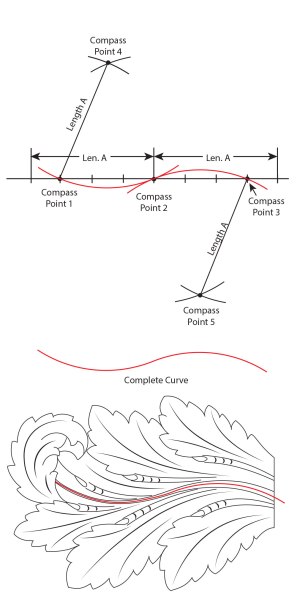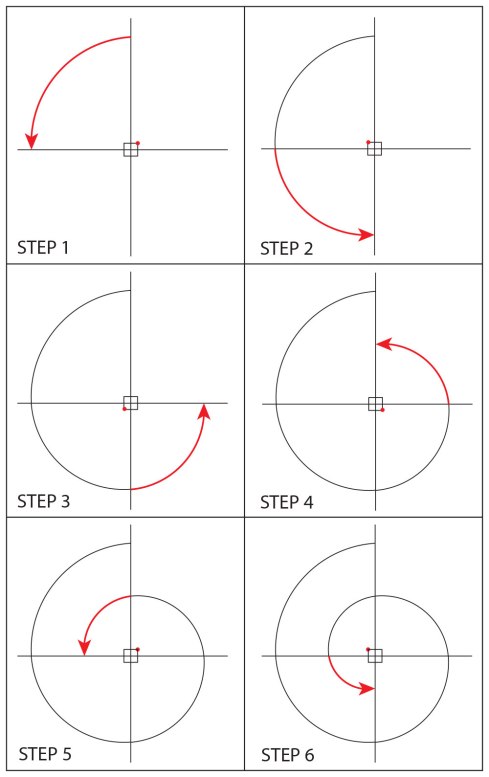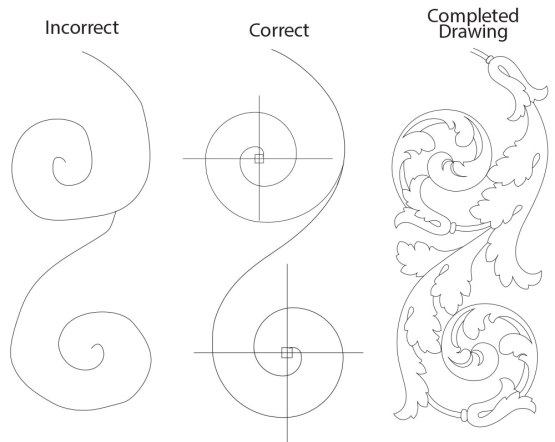 This is an excerpt from “Carving the Acanthus Leaf” by Mary May.
This is an excerpt from “Carving the Acanthus Leaf” by Mary May.
DRAWING THE SYMMETRICAL ‘S’ CURVE
This example works with multiple curves and shows how to draw a symmetrical design that identifies the midrib of the leaf for Chapter 5. By using a compass and a horizontal line divided into eight segments, a slow, gentle “S” curve (also referred to as a cyma curve) can easily be drawn.
• Draw a horizontal line and divide it into eight equal segments.
• Set your compass to Length A (four segments).
• Position the compass point on Compass Point 1 and strike a mark above the line as shown.
• Position the compass point on Compass Point 2 and strike another mark above the line, creating Compass Point 4 where the lines intersect.
• Place the compass point at Compass Point 4 and draw an arc intersecting the horizontal line at Compass Point 1 and also Compass Point 2.
• Notice that the distance between Compass Point 1 and Compass Point 2 is only three segments, thereby causing the arc to become slower, or more open.
• Position the compass point on Compass Point 2 and strike a mark below the line as shown.
• Position the compass point on Compass Point 3 and strike a mark creating Compass Point 5 where the lines intersect.
• Place the compass point at Compass Point 5 and draw an arc intersecting the horizontal line at Compass Point 2 and also Compass Point 3.

DRAWING A SPIRAL
Now let’s draw a more challenging curve – the spiral, scroll or volute. Many acanthus leaves terminate with a spiral shape at the base of the leaf, while other designs have entire leaves curling in the shape of a spiral.
This process shows the technique of drawing a basic spiral using straight lines and a compass.
• Draw a vertical and horizontal line with a small square at the intersection. The larger the square, the more open the spiral; the smaller the square, the tighter the spiral.
• Begin by placing the compass point at the upper right corner of the small square and strike a curve in only the upper left quadrant. The size is your choice – try experimenting with various sizes.
• Moving counterclockwise around the small center square, reposition the compass point to the upper left of the square and strike a curve in the lower left corner, beginning and connecting with the end of previous curve.
• Continue repositioning the compass point counter-clockwise around the small, center square and repeat the steps above, forming a continuous spiraling line.

The illustration above shows an incorrect flow of a spiral, a correct flow using the compass method shown and the completed drawing of the Baroque style leaf based on the curves drawn (Chapter 16). Notice how your eye is invited to follow along the gentle curves of the correctly flowing line, where the incorrect lines are jarring and uncomfortable to view. The lines represent the approximate center of the leaf. Notice the line that joins the two scrolls is drawn freehand and should appear to be flowing directly from the top scroll as shown.
— Meghan B.